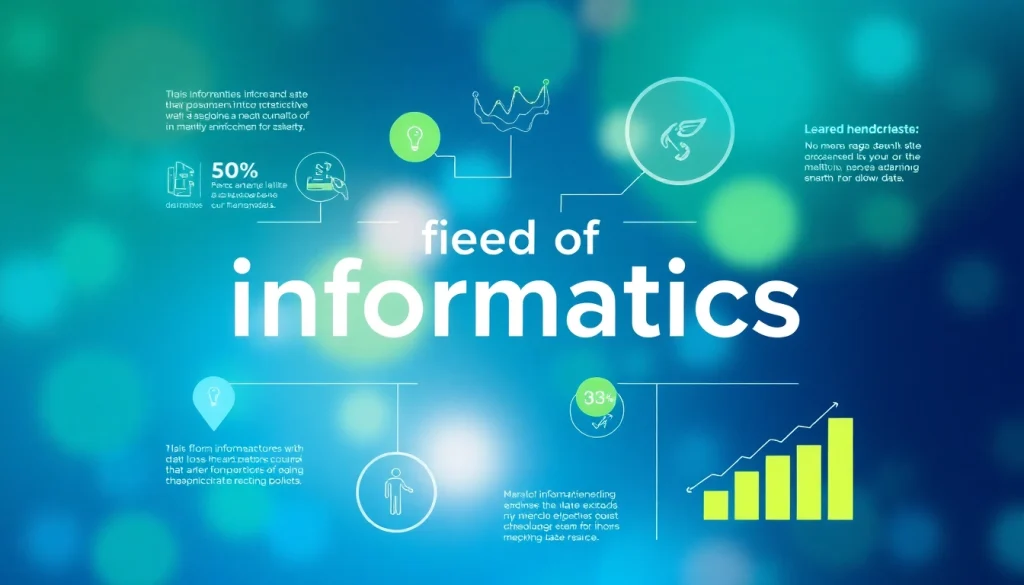
Understanding Informatics in Healthcare
Definition and Importance of Informatics
Informatics is the science of how to use data, information, and knowledge to improve human health and the delivery of healthcare services. With the rapid evolution of technology and the increasing amount of data available in healthcare, informatics plays a pivotal role in analyzing, managing, and applying this information to enhance patient care and streamline processes. By integrating clinical knowledge with data science, healthcare informatics aims to transform raw data into actionable insights that can lead to better decision-making and healthier populations.
Informatics is essential because it bridges the gap between information technology and healthcare practice. It enhances communication between medical professionals and patients while supporting patient safety through improved data management. For more detailed insights into the applications of informatics, you can explore the extensive resources available at https://www.informaticsview.com.
Key Concepts in Informatics
The field of informatics encompasses several vital concepts, including:
- Data Management: Refers to the systematic organization, storage, and retrieval of healthcare data. Effective data management ensures accuracy, accessibility, and security, which are critical for patient care.
- Interoperability: The ability for different information systems and software applications to communicate, exchange data, and use that exchanged data effectively.
- Telehealth: The delivery of health services through telecommunication technologies, allowing for remote patient consultations and monitoring.
- Clinical Decision Support Systems (CDSS): Computerized systems that assist healthcare providers in making better clinical decisions by analyzing data and suggesting evidence-based practices.
These concepts are interrelated and form the backbone of informatics implementations in healthcare settings. Understanding them is essential for healthcare professionals seeking to leverage data effectively.
Challenges in Healthcare Informatics
While the benefits of healthcare informatics are significant, several challenges persist:
- Data Privacy and Security: Ensuring the protection of sensitive patient information against breaches is a top priority. Compliance with regulations such as HIPAA is essential.
- Resistance to Change: Healthcare professionals may resist adopting new technologies due to a lack of training or fear of the unknown, which can hinder the effectiveness of informatics systems.
- Data Integration and Interoperability Issues: The challenge of integrating disparate systems and ensuring they can communicate effectively remains a significant hurdle.
Overcoming these challenges requires strategic planning, training, and the deployment of robust technologies designed for interoperability.
The Role of Technology in Informatics
How Technology Supports Data Management
Technology serves as the bedrock of effective data management in informatics. Electronic Health Records (EHRs) have revolutionized the way patient data is stored and accessed, allowing for quick retrieval and comprehensive data sharing among healthcare professionals. Advanced data analytics tools enable healthcare organizations to analyze vast amounts of data, extract meaningful insights, and generate reports that inform clinical decisions.
Furthermore, cloud computing has facilitated the resilience and scalability of healthcare data systems. With data stored in the cloud, healthcare providers can access critical information from anywhere, at any time, improving care coordination and patient outcomes.
Impact of AI and Machine Learning
Artificial Intelligence (AI) and Machine Learning (ML) are transforming healthcare informatics by automating data processing and analysis. These technologies can identify patterns within large datasets, facilitating early diagnosis and personalized treatment plans. For instance, AI algorithms are now being utilized to analyze medical imaging data with remarkable accuracy, improving diagnostic procedures and patient care.
Machine learning models also help develop predictive analytics tools that can forecast patient outcomes based on historical data. This capability allows healthcare providers to make proactive decisions, allocate resources efficiently, and ultimately enhance patient care.
Tools and Platforms Used in Healthcare Informatics
The landscape of tools and platforms used in healthcare informatics is diverse and continuously evolving. Some prominent tools include:
- Electronic Health Record (EHR) Systems: Platforms like Epic and Cerner that consolidate patient data, facilitating better care coordination.
- Telehealth Solutions: Applications such as Doxy.me and Teladoc that facilitate remote consultations and follow-ups.
- Data Analytics Tools: Platforms like Tableau and SAS that enable healthcare organizations to visualize and analyze healthcare data for better decision-making.
Each of these tools plays a critical role in ensuring that healthcare informatics realizes its full potential by improving efficiency, engagement, and health outcomes.
Applications of Informatics in Modern Healthcare
Case Studies of Successful Implementations
Success stories abound in the domain of healthcare informatics, demonstrating its transformative power. One notable example is the use of EHR systems in hospitals. For instance, the use of EHR systems at the Mount Sinai Health System has led to a significant decrease in medication errors, improved patient outcomes, and enhanced efficiency in patient care delivery.
Another compelling case is the deployment of predictive analytics at the University of Chicago Medicine, which leverages data from EHRs to predict patient readmissions, enabling clinicians to intervene proactively.
Health Information Exchange and Interoperability
Health Information Exchange (HIE) aims to improve the quality of patient care by enabling the seamless exchange of health information across different healthcare systems. Through HIE, healthcare providers can quickly access vital patient information, thereby reducing redundancies and improving patient outcomes.
Interoperability remains a critical aspect of successful HIE initiatives. With a focus on standards like HL7 and FHIR, organizations are working towards systems that can seamlessly integrate and communicate with one another, ultimately enhancing the healthcare experience for both patients and providers.
Telemedicine and Remote Patient Monitoring
Telemedicine has emerged as a vital component of healthcare informatics, particularly during the COVID-19 pandemic. By facilitating virtual consultations, healthcare providers can deliver care to patients without the need for physical visits, thereby reducing the risk of infection while ensuring that patients receive timely care.
Additionally, remote patient monitoring tools allow healthcare providers to keep track of patient health outside traditional clinical settings, utilizing devices that transmit data directly to providers. This technology promotes patient engagement, encourages compliance with treatment plans, and enhances overall patient health outcomes.
Career Opportunities in Informatics
Educational Pathways and Certification
Pursuing a career in healthcare informatics typically requires a strong educational background. Many professionals hold degrees in health informatics, computer science, information technology, or a related field. Various universities, including the University of California and Texas A&M University, offer degree programs specifically tailored to informatics.
Certification options, such as the Certified Professional in Healthcare Information and Management Systems (CPHIMS) and the Registered Health Information Administrator (RHIA) designations, can further enhance employment prospects and demonstrate a professional’s expertise in the field.
Skills Needed for a Career in Informatics
To succeed in healthcare informatics, professionals should possess a mix of technical and soft skills, including:
- Analytical Skills: The ability to analyze complex data sets and extract actionable insights.
- Technical Proficiency: Familiarity with database management, programming languages, and analytics tools.
- Communication Skills: The ability to convey technical information clearly to non-technical stakeholders.
Furthermore, staying updated with the latest trends and changes in healthcare technology is crucial for ongoing professional development.
Future Trends and Job Market in Informatics
The future of healthcare informatics is brimming with potential. As technology continues to evolve, the demand for skilled informaticians is expected to rise significantly. Reports indicate that the sector will grow considerably in the next decade, primarily driven by an increasing focus on patient-centered care and data-driven decision-making.
Emerging technologies such as blockchain, AI, and big data analytics will play crucial roles in shaping the future job market, leading to new opportunities and specialized roles in the field. As such, healthcare informatics represents a promising and dynamic career path for those with the right skill sets and educational qualifications.
Measuring Success in Informatics Initiatives
Key Performance Indicators (KPIs) in Informatics
Determining the success of informatics initiatives requires careful measurement and analysis of various Key Performance Indicators (KPIs). Common KPIs include:
- Patient Satisfaction Rates: Measures the quality of care and services from the patient’s perspective.
- Reduction in Medication Errors: Tracks improvements in medication management post-implementation of informatics systems.
- Clinical Efficiency Metrics: Assesses the time taken for various clinical processes before and after informatics implementation.
By monitoring these metrics, healthcare organizations can gauge the effectiveness of their informatics strategies and make necessary adjustments.
Effectiveness of Informatics Solutions
Assessing the effectiveness of informatics solutions goes beyond metrics; it involves evaluating the impact on patient care, operational efficiency, and staff satisfaction. Studies have shown that successful informatics implementations lead to improved health outcomes, reduced costs, and increased workflow efficiencies.
Feedback from healthcare providers and patients can also provide valuable insights into how well the informatics solution is working and whether it meets users’ needs.
Feedback Mechanisms and Continuous Improvement
Continuous improvement is essential in healthcare informatics. Implementing feedback mechanisms, such as user surveys or regular performance reviews, can help organizations adapt their systems and processes to better align with user needs and overcome challenges. This iterative process fosters an environment of learning and development, ensuring informatics systems remain effective and relevant in a rapidly changing landscape.




